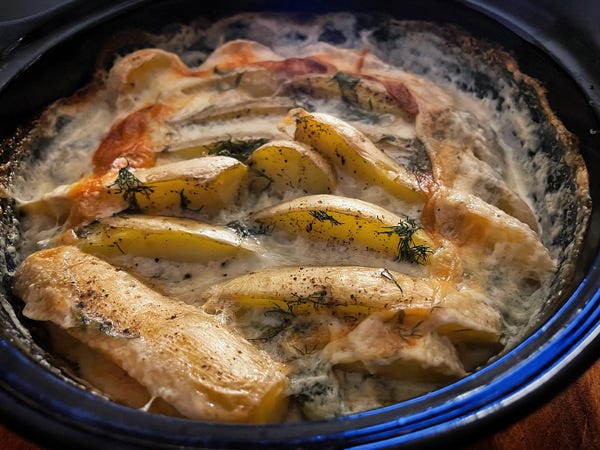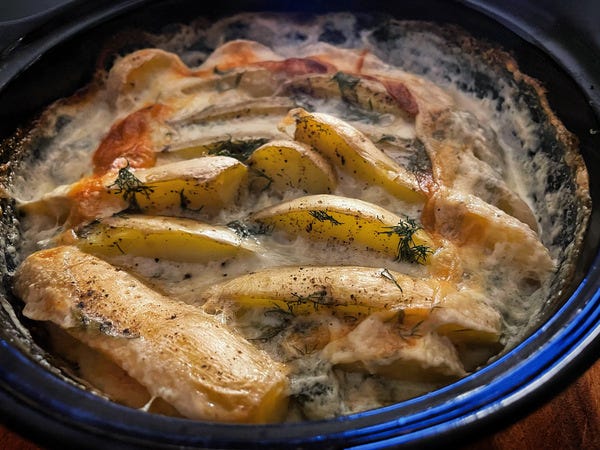I was nine the first time I ever had food poisoning. My German grandmother served me deli ham that had long soured and developed a curiously sticky and shiny patina.
She didn’t intentionally set out to harm me. She was a practical woman who had lived through wars and a depression. Born in east Germany, she saw her house taken by invading Russian soldiers looking for a place to decamp. Making a dangerous escape to the west as the Wall was being built, she narrowly evaded officers again by lying about visiting relatives in a nearby cabin. Settling in Lüneburg as a teen all alone, she built a life from scratch. She met my Opa there, and they were happy for a while. Until (what was then) Czechoslovakia was invaded and she feared history repeating itself. So, in 1962 she moved to Canada with her young family and once again started over, in a post-war country highly suspicious of Germans and not to eager to give them any leeway.
My Oma knew how to stretch a dollar, pinch a penny, and use every last scrap. Nothing went to waste. Not even the thick green leaves that hug a cauliflower. Those went into the soup.
Not even the old ham. That went into me.
She fried it on really high heat to kill anything nefarious lurking under that slick slime. Sprinkled on a little seasoning to mask the sour smell.
She was fine.
I barfed all night.
However, in the morning I was right as rain, and surprisingly ready for breakfast. Toast and jam. Nothing too risky there. Probably.
When I was in high school, I went to my best friend’s house. Her mother was feeding the dog left over pizza. I was starving and incredulous.
“Why is she doing that?” I asked.
“Oh, someone forgot to put the pizza in the fridge last night, so it’s no good anymore,” my friend answered.
“What?! I’ll eat it!”
“You can’t eat meat that’s been left out, Erin!!” now it was my friend who was incredulous.
It was news to me.
Throughout my childhood, it was never even a consideration to refrigerate dinner leftovers. While our kitchen clean up was run with military precision, the countertops and floors left gleaming without a crumb in sight, the evening’s stew, soup, or sauce would be neatly left in its cooking pot, lid on, on the back burner of the cold stove, conveniently located to be re-heated the next day, or day after that. Why waste time and energy hauling a heavy pot in and out of the fridge? We are German, after all. We thrive on efficiency.
I distinctly remember leftover rouladen, one of my favourite dishes of beef rolls stuffed with onion, pickle, and bacon and braised in broth. It had grown a thick, fatty, green film overnight. The oily slick lay semi-solid, like an algae blanket over a stagnant pond. A simple blast of a high heat took care of that; the sludge melted away in seconds, destroying any evidence something was potentially amiss.

I don’t think I’m alone in my fast-and-loose upbringing around food safety. A few weeks ago I was asked to host a food and wine pairing educational dinner. I was telling the chef, a woman about 10 or 12 years older than me, about my childhood diet, and she was nonplussed. Leaving food out was de rigueur in her household as well!
Perhaps this is just another jewel in the crown of the rough-and-tumble Gen X survivors. Without the internet and the alarming shrill of 24-hour news cycles, we lived in blissful ignorance of all the monsters under the bed – and the casserole lid. We weren’t really aware of pesky details like sunburns, second-hand smoke, and Salmonella.
I think I’m better for it. I may have flown close to the sun a few times, but I’m rarely sick as an adult, and attribute that stamina to my laissez-faire childhood diet. (My hypothesis has yet to be proven by science.)
À noter: If you have been among the friends who have feasted at my house, don’t panic: while I may still obey the five second (five minute?) rule for myself, I am mindful of my Food Handler training. I’m far too entrenched in years of restaurant work (some call it PTSD) to ever go rogue.
Painter’s tape and pens sit in the kitchen drawer ready for labelling any and all containers with dates and contents; meats and “dangerous items” are safely packaged and stored on lower shelves of my fridge in case of menacing drips; soups and sauces and “delicate items” are kept safely on higher platforms.
I would be mortified if anyone fell ill by my careless hand. I walk the very strict and straight line for anything I serve to guests.
But back to me and my danger-seeking diet.
This week I put out a survey on my Instagram, with the photo above, asking who would and who wouldn’t. You probably can guess the answer. My compatriots – the ones who recklessly rode bikes without helmets through the neighbourhood until the streetlights came on – gave it a hearty endorsement.
I was eager to try a hearty recipe from one of my favourite food writers, Nigel Slater. This light riff on a French tartiflette, rich and hearty for a bone-chilling winter/spring evening, appeared in his weekly newspaper column. As the weather had once again turned frosty in Toronto, my dinner plans rested on this delicate, blue-speckled Taleggio. Like my Oma and the ham – what options did I have?
As the wind whipped fat snowflakes sideways outside my window, I lopped off the moldy bits (Bon Appetit says it’s ok!) and carried on cooking, aromas of cheesy, creamy goodness quickly filling my kitchen as they bubbled in the pan.
An hour later, moldy scraps in the garbage, I happily ate every last bite.
And I’ve lived to tell the tale. Just like when I was nine.
Where do you fall on the side of questionable food practices?
Potato and Taleggio Bake
Nigel Slater’s recipe calls for Camembert and “yellow waxy” potatoes. I had fingerlings and Taleggio, so that’s what I used. What I always appreciate about Mr Slater’s recipes is that they are flexible to what you have on hand and still turn out wonderfully. And truth be told, I don’t really measure, I just make enough potatoes to fit the casserole dish, and stuff cheese between them until I’m satisfied.
While this is a side dish, its rich decadence suggests letting it be the star of the show. I served it alongside a simple roast chicken, Mr Slater suggests smoked salmon could be nice.
Chef level: easy
Makes: About a pound (for my crowd that’s enough for 3 people)
Ingredients:
1 lb fat fingerling potatoes
1 cup Taleggio, torn into pieces
1 cup 35% cream
salt and pepper to taste
Handful fresh dill
How to Make It:
Bring a large pot to a boil. When ready, lightly salt the water and add the fingerlings.
Cook for about 20 minutes until a knife easily pierces them.
Set the oven to 350°F.
Drain, and when cool enough to handle slice length-wise in half, and line in a single layer in a 1.5 quart casserole dish.
Between each layer, stuff a piece of Taleggio.
Sprinkle salt, pepper, and fresh dill over top.
Gently pour in the cream until it reaches about 1/4 way up the potatoes.
Cover the casserole with a lid or tin foil and bake for 20 minutes.
Remove the lid and continue to bake for another 25 minutes until the potatoes are meltingly soft and the cream mixture is thick and bubbly.
Wine Pairing:
Of course, you can choose to match the weight and flavour of the casserole with a rich and creamy wine such as a Chardonnay or Alsatian Pinot Gris. My sister’s tastes fall to the luxe, and would happily lap up both. (In fact, she often calls me a buzz kill when I reach for something lighter.)
For me, I prefer to contrast the decadence of the food with a zippier wine. Chablis, still a Chardonnay, but one with no oak from the cool north of Burgundy, works well to mop up some of the fat.
Red wine lovers might do well with a leaner, spicier northern Rhône Syrah, such as something from Saint-Joseph. These wines range in flavour, but generally have appealing smoke, pepper, and bacon notes, with a fresh acidity.








This dish looks so good! I'm sending it to my husband. He's the cook in our home.